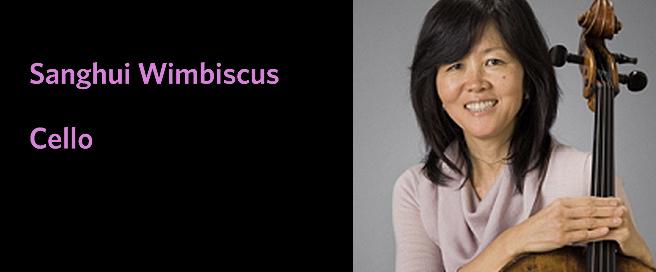Teacher Spotlight: Sanghui Wimbiscus, cello

December 10th, 2017
Sanghui Wimbiscus, cello
Interview by Erin Cano, violin
Sanghui joined MIC as a Suzuki cello teacher in 2014.
What led you to become a Suzuki teacher?
My first teaching position after graduating with a performance degree was teaching cello at a college. Most of the students had not been trained well, and it was a pretty enormous task to try to undo years of bad habits developed from the lack of a good foundation. It was almost too late for the students by that stage of development to learn the proper way of playing. As a result of that experience, I became interested in working with young students so that they would have a solid foundation on which to build. My next position was teaching children, one of whom was only four years old. I realized I had no idea how to approach someone younger than the traditional seven-year-old beginner. Having begun my own cello studies at age 13, I couldn’t even look back on my own experience. It was at this time that I felt the Suzuki method, which specializes in working with the very young, would provide me with the training I needed; and it certainly has.
Which of your teachers inspired you the most? What aspects of their teaching have you integrated into your own style?
I was very inspired by one of my first teachers, Stephen Kates. He was a wonderful cellist with an incredibly beautiful tone. The highlights of my time with him were hearing him play and playing duets with him at the end of each lesson. The chasm between our playing was enormous, but he was the best role model of an outstanding cellist and a musician. I was also heavily influenced by one of my last teachers, Harvey Shapiro. Although I only studied with him for a short time, he taught me a completely different approach to cello playing than I had previously experienced. He addressed areas of tension in my playing that I had not been aware of. That had a profound effect on my playing and deeply influenced my teaching approach.
Based on my own experience of not having a good foundation in the beginning of my studies and paying the cost later on, I feel a strong commitment to help my students develop a firm foundation on which they can build. If they are unencumbered by bad habits or the ill use of the body, they will eventually be free to express themselves fully. I like to say that my job is to give them wings so that they can learn to fly.
What is your favorite Suzuki piece to teach?
I like to teach French Folk Song. It’s beautiful, simple, and something you can revisit over and over again for various aspects of teaching and at many levels. There are some beautiful ensemble versions of it as well.
You’re the mom of two Suzuki children. What insights have you developed as both a Suzuki parent and teacher?
For me, it worked well to stay behind the scenes during the lessons. Observe everything, take notes, and ask questions if needed. I let the teacher be the full teacher during lessons, and I became the teacher at home.
Do you play any other instruments besides the cello?
After I begged my mom for a couple of years for cello lessons, she finally acquiesced to find a cello teacher for me. She consulted my sisters’ elderly Ukrainian piano teacher for a recommendation. To my utter dismay, rather than recommending a cello teacher, she stated that I must study piano for two years prior to starting cello. Without question, cello was put on hold. I was not happy about the situation at the time but I am grateful now to be able to play piano at all. My only wish is that I could play better so I that I would make fewer mistakes when accompanying my two cellist daughters at home. My little six-year-old, however, finds great amusement from my many mistakes. All is not lost.
